Sydney Trains A & B sets
| Waratah | |
|---|---|
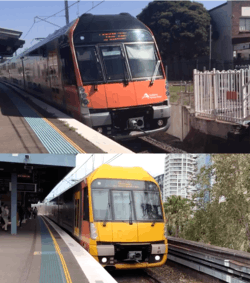 Top: Waratah Series 2 B2 at Sefton Station
Bottom: Waratah Series 1 A45 at Milsons Point Station | |
| In service | 2011-present |
| Manufacturer |
|
| Built at | Changchun Railway Vehicles, Changchun, China and Downer Rail, Cardiff |
| Replaced | Sydney Trains S sets |
| Constructed |
|
| Entered service |
|
| Number under construction | 18 |
| Number in service |
A Sets 77 B Sets 2 |
| Number scrapped |
1 (A2) - Acid spill while in transit back to China |
| Formation | 8 cars |
| Fleet numbers |
|
| Capacity | 896 seated including 16 wheelchair spaces |
| Operator(s) | Sydney Trains |
| Depot(s) | Auburn |
| Line(s) served | |
| Specifications | |
| Car body construction | Stainless Steel |
| Train length | 163.1 m (535 ft 1 in) |
| Car length | 20.000 m (65 ft 7 in) |
| Width | 3.035 m (9 ft 11 in) |
| Height | 4.410 m (14 ft 6 in) |
| Maximum speed | 130 km/h (81 mph) |
| Weight | 404 t (398 long tons; 445 short tons) |
| Traction system |
IGBT-VVVF 3 Phase AC induction motor spread spectrum modulation (Hitachi) |
| Acceleration | 1 m/s2 (3.3 ft/s2) |
| Deceleration | 1 m/s2 (3.3 ft/s2) |
| Train heating | Two independent cooling units per car: 38 kW (51 hp) cooling, 24 kW (32 hp) heating |
| Electric system(s) | 1,500 V DC catenary |
| Current collection method | pantograph |
| Braking system(s) | Regenerative brake with blended electro-pneumatic wheel mounted disc brakes (Supplier: Knorr-Bremse (Pneumatics) and Hitachi (Traction)) |
| Track gauge | 1,435 mm (4 ft 8 1⁄2 in) |
The Sydney Trains A & B sets both also known as Waratah are classes of electric multiple unit trains operated by Sydney Trains in Sydney, New South Wales, Australia. The trains were named Waratah by the New South Wales Government after the flower of the same name, which is the state's floral emblem.
The Waratah design is based on the M set. The initial order for 78 series 1 Waratahs was the largest rolling stock order in Australia's history. These 626 A set carriages make up around half of the Sydney Trains fleet, and replaced two-thirds of the 498 S set carriages. Delivery commenced in July 2011 and was completed in June 2014.
An order for an additional 24 trains of a similar design was placed in December 2016. These are known as B set or Waratah Series 2 trains, with all sets expected to be delivered by early 2019.[1] The first entered service in September 2018.
Public Private Partnership
The series 1 carriages were delivered by a joint venture between Downer Rail and Hitachi for Reliance Rail under a Public Private Partnership (PPP).[2] As part of the PPP, Reliance Rail will also maintain the trains for a minimum of 30 years at the purpose built Auburn Maintenance Centre facility.[3] At least 72 sets must be made available to Sydney Trains every day during the contract period.
Reliance Rail took on debts of $2.4 billion at cheap interest rates before the global financial crisis.[4] Higher interest rates and changes in the financial sector after the GFC meant the company would have difficulty refinancing its debt, leading the Government of New South Wales into talks with Reliance Rail to resolve the financial status of the project.[5] In February 2012 the Government agreed to bail out the project for $175 million by becoming the sole shareholder in 2018.[4][6][7]
Design
The Waratah was designed at the Downer EDI Rail design offices, then at Clyde, New South Wales. The sets are formed of eight carriages – a break from the previous standard Sydney practice of four car sets, which are then coupled to form eight car trains. The configuration is: driving trailer car + motor car + motor car + trailer car + trailer car + motor car + motor car + driving trailer car.[2] This means that guards operate from the rear of the train rather than the centre and that commuters are able to walk through the entire train in an emergency. The trains include external CCTV cameras to assist guards.[8]
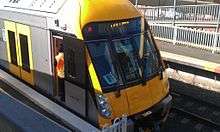
Carriage interiors were designed by Transport Design International.[9] The inside of the train includes additional Emergency Help Points and CCTV cameras compared to older classes. Improvements to the DVAs (Digital Voice Announcements) with differential pitch of the voice allow more natural sounding speech. ‘Smart’ air-conditioning automatically adjusts to the outside temperature and the number of passengers on board.[10] Accessibility features include 16 wheelchair spaces, portable wheelchair ramps in the end cars, red fabric on priority seating and additional handrails compared to older trains in the fleet.[8]
The A set is the first passenger train in the world to use LED lamps for all lighting (except headlights). In doing so, the designers managed to remove almost 800kg in reflectors and ballasts associated with fluorescent units, as well as reducing power consumption to around a quarter of that used by fluorescents.[11] Woollen moquette fabric, a durable, vandal-resistant material, is used to cover the train's seats. The seats use specially developed shock absorbers such that the reversing feature is damped - this was a safety feature added to allow reversible seats which would contain passengers in the event of an accident.[11] Detailed design of the train was completed in July 2009.[12]
The series 2 trains share more than 90 percent of their design with the original Waratahs.[13] The trains' exterior features the same silver and yellow design as the A sets, however, the trains entered service with a black, orange and silver wrap applied to the cabs, and additional black sections around the side windows.[14]
Construction and delivery
Series 1

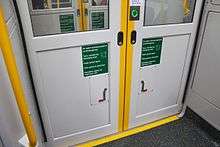
The joint venture between Downer EDi Rail and Hitachi was established to design, manufacture and commission the series 1 trains.[2] The stainless steel bodies were partially constructed by Changchun Railway Vehicles in China before being shipped to Downer EDI’s Cardiff Locomotive Workshops facility for final assembly, testing and commissioning.[2] The manufacturing facility at Cardiff received an upgrade of over $20 million to cater for the needs of the project.[2] Other infrastructure works included the construction of the Auburn Maintenance Centre and new substations at various locations around the network.[15]
A four car pre-production test train was built to test the train sub-systems and compatibility with the Sydney suburban network.[2] This was intended to allow any issues with the train to be corrected before the production trains entered service.[2] The test train was expected to perform trial runs from mid 2009,[2] but did not begin network testing until April 2010.[16] The pre-production train concluded testing in August 2010.[17] The first production set began network testing in August 2010[17] and by November 2010, three sets were undergoing testing.[18]
The first trains were scheduled to be introduced in late 2010, but a series of delays pushed back their introduction.[19][20] The first train intended for service (A3) was delivered to then-operator CityRail for acceptance on 20 April 2011.[21] CityRail had 20 business days to accept or reject the train, but a decision was postponed by two weeks to allow Downer EDi to correct further defects.[22] CityRail rejected the train due to safety concerns and a number of defects.[23] The defects included; 'milky' effect windscreens – apparent when under direct sunlight, poor-quality steel welding as evident in the indents seen on some areas of the carriage exterior, gaps in the plastic moulding, handrails not lining up with stairs and software problems.[7][24]
Once the majority of the problems were resolved by Downer EDi, CityRail allowed A3 to commence service, though operating under special conditions.[25] It entered service on 1 July 2011,[26] operating its maiden run from Redfern to Macarthur via the City Circle and Airport. Initially, it operated two return services from the City to Macarthur via the Airport line during the off-peak period on weekdays, and all day on the Airport & East Hills and South lines on weekends. On 14 October 2011, A3 became the first Waratah set to operate during peak hours.[27] As more Waratahs became available, the trains were progressively rolled out to most lines of the Sydney suburban network. On 2 June 2014, it was announced that the final Waratah set (A80) had been delivered.[15]
Originally, the Waratahs were intended to replace all 498 S set carriages,[28] but in February 2013 it was revealed that some S sets would still be required in order to provide services on the South West Rail Link.[29] An option existed to extend the order, but in March 2013 the government indicated it would not take this up.[30]
Series 2
Despite proceeding with the intercity train order, the New South Wales Government announced on 1 December 2016 that 24 new suburban trains had been ordered. Known as the Sydney Growth Trains during development, the trains are officially classified as B sets and are also known as Waratah Series 2 trains.[31][32]
The $1.7 billion contract was awarded to Downer EDI. CRRC Changchun Railway Vehicles is manufacturing the trains on Downer's behalf.[13] Upon arrival in Australia, the trains are taken to Downer's facility at Cardiff, where commissioning works are performed.[31][14][33][34]
Downer EDI will maintain the trains for a minimum of 25 years. As many as 45 additional sets may be added to the order at a future date.[13][35][36][37] The trains were originally to be based at the Mortdale Maintenance Centre, but in late 2017 it was decided that the trains would instead be based alongside the A sets at the Auburn Maintenance Centre. Nevertheless, work to upgrade the Mortdale Maintenance Centre continued.[38][39]
The trains feature improved air conditioning, accessibility and internal lighting, with new and revised features such as LCD Indicators and LCD video screens as well as more than 90 internal and external CCTV cameras.[40][1]
The first B set to be delivered was unveiled to the media in March 2018.[41][42] Set B2 was the first to enter revenue service on 7 September 2018, beginning with a run from Granville to Liverpool.[43] On 18 September 2018, B2 became the first Waratah Series 2 to operate during peak hours.
The B sets are scheduled to replace the 48 remaining S sets, but it is unknown if all of them are being replaced as some may remain for emergency purposes and will be needed for the new timetable in 2019 when the Sydney Metro opens.[40][32]
In service
Formation
The 626 carriages form 78 eight car sets (numbered A1, A3 to A78 and A80) with 2 spare driving cars. Individual vehicles are numbered as follows:
- A1: D6301-N5301-N5501-T6501-T6601-N5601-N5401-D6401
- A3: D6303-N5303-N5503-T6503-T6603-N5603-N5403-D6403
up to
- A78: D6378-N5378-N5578-T6578-T6678-N5678-N5478-D6478
- A80 (Replacement for A2): D6380-N5380-N5580-T6580-T6680-N5680-N5480-D6480
The two spare driving cars are D6379 and D6479. These were the first vehicles delivered, along with N5342 and N5442, and are part of the four car testing and development train.
The 192 B set carriages will form 24 eight carriage sets.[44] Individual vehicles are numbered as follows:
- B1: D1101-N1701-N1901-T1301-T1401-N1801-N1601-D1201
up to
- B24: D1124-N1724-N1924-T1324-T1424-N1824-N1624-D1224
The first 40 A sets were delivered to CityRail with the NSW Government's Waratah logo on each carriage. Following the formation of Sydney Trains in July 2013 these were replaced by the Sydney Trains logo and the sides of the train near the driver's cabs were covered with an orange wrap.
Waratahs currently operate on these lines:
- T1 North Shore, Northern, Western Line: City to Hornsby or Berowra via Gordon, Hornsby to City via Strathfield, City to Penrith or Richmond via Parramatta (A sets only)
- T2 Inner West & Leppington: Leppington or Parramatta to City Circle via Granville
- T3 Bankstown: Liverpool or Lidcombe to City Circle via Bankstown
- T5 Cumberland: Leppington to Richmond (A sets only)
- T7 Olympic Park: Lidcombe to Olympic park (A sets only)
- T8 Airport & South: Macarthur to City Circle via Airport or Sydenham
In service incidents
On 22 January 2018, Waratah A42 hit the buffer at the end of the track on platform 2 at an approximate speed of 35 kilometres per hour at Richmond station just before 10am. The train then lurched backwards, causing leading passengers who were readying to disembark, to fall and injure themselves. The impact caused extensive frontal damage, some of the carriages to lift and gangways between carriages to crush. Sixteen patients in total, including the train driver and another crew member were treated. None of the injuries were considered life threatening.[45][46]
Gallery
- A set
 Lower deck
Lower deck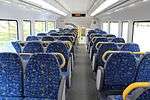 Upper deck
Upper deck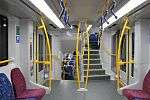 Stairs, hand rails, doors and longitudinal seating
Stairs, hand rails, doors and longitudinal seating Seats in some of the vestibules can be folded up to improve access for wheelchair users, the red fabric indicates 'priority' seating for less mobile people who don't require a wheelchair
Seats in some of the vestibules can be folded up to improve access for wheelchair users, the red fabric indicates 'priority' seating for less mobile people who don't require a wheelchair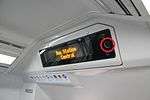 Each Internal destination LED indicator includes a CCTV camera (circled) beside it to monitor carriage activity
Each Internal destination LED indicator includes a CCTV camera (circled) beside it to monitor carriage activity The trains are the only Sydney Trains fleet to feature external CCTV cameras to assist Guards when it is not possible to view the platform physically
The trains are the only Sydney Trains fleet to feature external CCTV cameras to assist Guards when it is not possible to view the platform physically End carriage vestibule
End carriage vestibule
- B set
 Revamped LCD Indicator showing current station with "stopping at..." scrolling underneath.
Revamped LCD Indicator showing current station with "stopping at..." scrolling underneath. LCD screen above doorway leading downstairs.
LCD screen above doorway leading downstairs.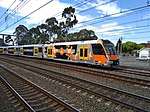 B set with advertising decals
B set with advertising decals
References
- 1 2 Waratah Series 2 EMUs enter service in Sydney Railway Gazette International 14 September 2018
- 1 2 3 4 5 6 7 8 Rolling Stock Public Private Partnership For Rail Corporation of New South Wales Downer EDi Rail
- ↑ Reliance Rail project page
- 1 2 Aston, Heath (29 January 2012). "Taxpayers' train bailout". The Sydney Morning Herald. Retrieved 29 January 2012.
- ↑ Haynes, Rhys (15 August 2011). "Waratah still long way off its peak". The Daily Telegraph. Retrieved 15 October 2011.
- ↑ "Baird launches $175m train bailout". The Sydney Morning Herald. 6 February 2012.
- 1 2 Budd, Henry (13 May 2012). "Waratah trains still bugged by problems". The Daily Telegraph.
- 1 2 Sydney's new train. Reliance Rail.
- ↑ "waratah". Axis Communications. Retrieved 20 July 2013.
- ↑ "The 'Waratah' train: some fast facts". CityRail xpress. 93. 5 August 2009.
- 1 2 "Key customer features". CityRail. Retrieved 31 January 2012.
- ↑ "Detailed design complete for Sydney's new train" (PDF) (Press release). RailCorp. 1 July 2009. Retrieved 31 January 2012.
- 1 2 3 "Downer awarded Sydney Growth Trains contract". Downer Group. 1 December 2016. Archived from the original on 20 February 2017. Retrieved 1 December 2016.
- 1 2 "Waratah Series 2 train arrives". YouTube. Transport for NSW. 4 April 2018. Retrieved 7 April 2018.
- 1 2 "NSW Government delivers final Waratah train: all Sydney services air-conditioned". Transport for NSW. 2 June 2014. Archived from the original on 6 June 2014. Retrieved 3 June 2014.
- ↑ "Project update: beginning of Waratah train fleet safety & reliability testing program" (Press release). Reliance Rail. 27 April 2010.
- 1 2 "Waratah train begins network testing" (PDF). CityRail xpress. 143. 18 August 2010. Retrieved 30 January 2012.
- ↑ Downer Statement on Waratah Trains. Downer EDI. 3 November 2010.
- ↑ "Waratah carriages delayed again". AAP. 3 November 2010.
- ↑ "Downer EDI takes $250mln charge on Waratah". AAP. 27 January 2011.
- ↑ Downer Presents First Waratah to Railcorp Downer EDI 20 April 2011
- ↑ Saulwick, Jacob (24 May 2011). "Waratah trains stalled again". The Sydney Morning Herald.
- ↑ Haynes, Rhys (3 June 2011). "Waratah trains a commuter threat". The Daily Telegraph.
- ↑ Henderson, Hartley (4 July 2011). "What if Australia had made the Waratah trains?". Manufacturers' Monthly.
- ↑ Saulwick, Jacob (15 June 2011). "Late Waratah trains held up over contract changes". The Sydney Morning Herald.
- ↑ Saulwick, Jacob (2 July 2011). "Preening Waratah makes its entrance". The Sydney Morning Herald.
- ↑ Where the Waratah train is operating
- ↑ Where the Waratah train is operating Sydney Trains
- ↑ New Trains Won't Run on All Rail Lines Channel 7 20 February 2013
- ↑ Commuters stuck with old trains on new rail link Sydney Morning Herald 15 March 2013
- 1 2 Asset Standards Authority. "Movement of Sydney Growth Trains (SGT) B Set cars between Woodville Junction and Sulphide Junction" (PDF). Transport for NSW. Retrieved 16 March 2018.
- 1 2 "New air conditioned trains arrive". Transport for NSW. 22 March 2018. Retrieved 22 March 2018.
- ↑ O'Sullivan, Matt (2016-12-01). "$1.7 billion in new Waratah trains for Sydney commuter network". The Sydney Morning Herald. Retrieved 2018-03-29.
- ↑ "'Sydney Growth Trains' Enter Revenue Service". Railway Digest: 18. October 2018.
- ↑ McNally, Lucy (2016-12-01). "Sydney trains to receive $1.5b boost for services to western suburbs". ABC News. Australian Broadcasting Corporation. Retrieved 2016-12-01.
- ↑ "Rail revolution: 'More Trains, More Services' to bust congestion". Transport for NSW. 2016-12-01. Retrieved 2016-12-01.
- ↑ "More Trains, More Services" (PDF). Transport for NSW. Retrieved 1 December 2016.
- ↑ "Fleet update - June 2017" (PDF). Transport for NSW. June 2017. p. 3. Retrieved 29 June 2017.
- ↑ "Sydney Growth Trains Mortdale Maintenance Centre December 2017 Work Notification" (PDF). Transport for NSW. Retrieved 5 December 2017.
- 1 2 O'Sullivan, Matt (2018-03-22). "New Waratah trains finally signal end to Sydney's 'sweat sets'". The Sydney Morning Herald. Retrieved 2018-03-22.
- ↑ O'Sullivan, Matt (12 July 2018). "All aboard: first new passenger trains set to enter service in Sydney". The Sydney Morning Herald.
- ↑ New trains face final test ahead of launch Transport for NSW
- ↑ With summer just around the corner we're a step closer tonight to a fully air conditioned fleet for Sydney's busy rail network. 7 News has an exclusive look at the first of a new batch of Waratah trains which took to the tracks. 7 News Twitter 7 September 2018
- ↑ "Rolling stock contracts & deliveries" Railway Digest March 2018 page 49
- ↑ Sydney train crash: Multiple injuries following incident at Richmond station
- ↑ Rail safety investigations & reports Australian Transport Safety Bureau
External links
| Wikimedia Commons has media related to New South Wales A sets. |